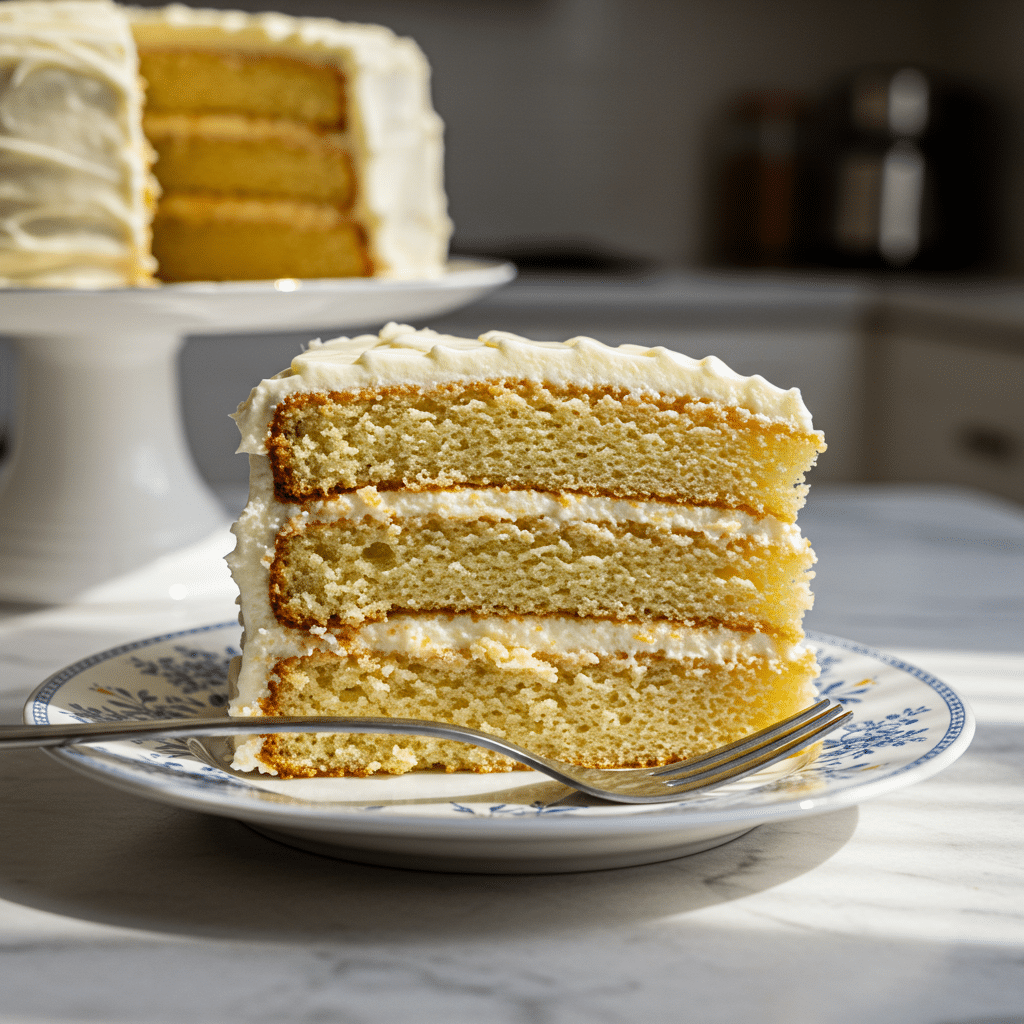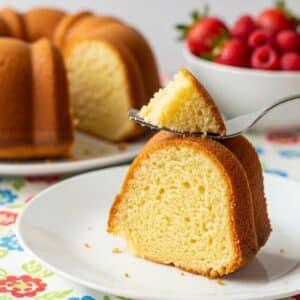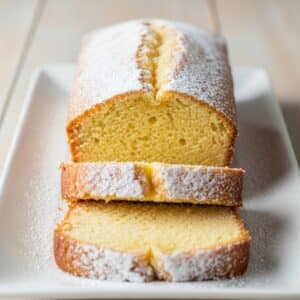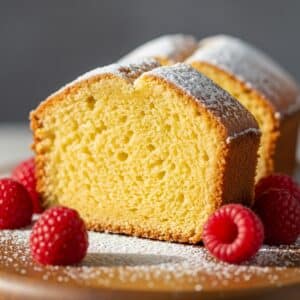There’s something timeless about a slice of vanilla cake. Soft, golden, and fragrant, it’s a dessert that fits every occasion — from birthdays to weekend gatherings. This Easy Moist Homemade Vanilla Cake delivers bakery-level texture and flavor using simple ingredients you already have at home. With its fluffy crumb, buttery richness, and smooth vanilla buttercream, it’s the kind of cake that never goes out of style. For another home-baked classic, see the Easy Carrot Cake by Gordon Ramsay, which shares the same balance of comfort and elegance.
The Essence of Vanilla Cake
Why Vanilla Cake Always Works
Vanilla cake has an understated charm. Its appeal lies in its simplicity and versatility. You can serve it plain with coffee, dress it up with frosting, or layer it for special occasions. This recipe captures everything people love about a perfect vanilla cake — light, tender layers with a rich flavor that’s never overwhelming.
🧾 Want to keep this recipe for later? Download your printable PDF version now and enjoy it anytime!
📥 Download Recipe PDF✅ Print-friendly • 🕒 Save for later • 📱 Mobile-accessible
💡 Want more like this? Subscribe to our weekly printable recipes!
The Secret to a Perfect Crumb
The key lies in the balance of moisture and air. A combination of butter, oil, and sour cream keeps this cake soft, while buttermilk ensures a tender texture. Beating the butter and sugar properly creates the air pockets that give rise to that fine, velvety crumb. It’s a cake designed for success every single time.
Print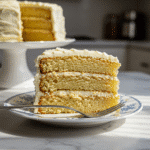
Easy Moist Homemade Vanilla Cake
Description
This Easy Moist Homemade Vanilla Cake is soft, buttery, and full of rich vanilla flavor, topped with a fluffy buttercream frosting that makes it perfect for any occasion.
Ingredients
3 cups all-purpose flour
1 tbsp baking powder
1/2 tsp baking soda
1 tsp salt
1 cup unsalted butter (softened)
2 cups granulated sugar
4 large eggs (room temperature)
1 tbsp vanilla extract
1 vanilla bean (optional)
1 cup buttermilk (room temperature)
1/4 cup vegetable oil
1/4 cup sour cream
Buttercream Frosting:
1 1/2 cups unsalted butter
5–6 cups powdered sugar
1/4 cup heavy cream
2 tsp vanilla extract
Pinch of salt
Instructions
1. Preheat oven to 350°F and prepare pans.
2. Whisk flour, baking powder, baking soda, and salt.
3. Cream butter and sugar until fluffy.
4. Add eggs one at a time.
5. Mix in vanilla and vanilla bean seeds.
6. Alternate adding dry ingredients and buttermilk mixture.
7. Fold in sour cream.
8. Pour into pans and bake 30–35 minutes.
9. Cool for 10 minutes, then remove.
10. Beat butter for frosting, add sugar gradually.
11. Add vanilla, cream, and salt; whip until fluffy.
12. Frost cooled cake and decorate as desired.
Notes
Bring ingredients to room temperature.
Avoid overmixing for a light crumb.
Cool completely before frosting.
Store frosted cake up to five days or freeze layers up to two months.
Preparing to Bake
Setting the Stage
Preheat your oven to 350°F and prepare your pans. Grease them thoroughly, line with parchment, and grease the parchment too. These steps prevent sticking and guarantee smooth release. This recipe works beautifully in two 8-inch pans, two 9-inch pans, or a single 9×13 pan, depending on how you plan to serve it.
Gathering the Ingredients
Before you begin, bring all ingredients to room temperature. Cold eggs or butter can cause uneven mixing and affect texture. You’ll need flour, baking powder, baking soda, salt, butter, sugar, eggs, vanilla, buttermilk, vegetable oil, and sour cream. For deeper flavor, add the seeds from a fresh vanilla bean — a touch that makes a big difference.
Mixing the Batter
Creating the Foundation
In a medium bowl, whisk together flour, baking powder, baking soda, and salt. This ensures the leavening agents distribute evenly. In another bowl or stand mixer, beat butter and sugar until light and fluffy — about three to four minutes. This step builds the structure for your cake, so don’t rush it.
Adding the Eggs and Flavor
Add the eggs one at a time, beating after each addition. The batter should look smooth and creamy. Then, mix in the vanilla extract and vanilla bean seeds. The aroma alone feels luxurious. These ingredients create the signature flavor that makes vanilla cake so irresistible, simple yet deeply satisfying.
Achieving the Perfect Moisture
The Secret Trio: Buttermilk, Oil, and Sour Cream
In a small measuring cup, whisk together the buttermilk and oil. These ingredients work together to keep the cake tender for days. The oil locks in moisture, while the acidity in buttermilk softens the crumb. Finally, fold in sour cream — a little addition that adds richness and creaminess without heaviness.
Combining Wet and Dry
Add the flour and buttermilk mixtures alternately into the creamed butter — start and end with flour. Mix on low speed until combined. This technique prevents overmixing and ensures a smooth, silky batter. When finished, the batter should fall off your spatula in thick ribbons. It’s light, luscious, and ready to bake.
Baking to Golden Perfection
Pouring and Baking
Divide the batter evenly between your prepared pans, smoothing the tops for an even rise. Bake for 30 to 35 minutes for 8-inch pans or 25 to 30 minutes for 9-inch ones. If you’re baking in a 9×13 pan, extend to about 40 minutes. The cake is ready when it springs back lightly and a toothpick comes out clean.
Cooling the Layers
Once baked, let the cakes cool in their pans for exactly 10 minutes — not more, not less. Then, run a knife around the edges and gently invert them onto a cooling rack. This step ensures the cakes stay intact and moist. Allow them to cool completely before adding any frosting to prevent melting or sliding.
Making the Buttercream Frosting
Beating to Fluffiness
In a clean mixing bowl, beat softened butter for at least three minutes until it turns pale and airy. Add two cups of powdered sugar and mix on low speed until incorporated. Then, pour in vanilla extract and a splash of heavy cream. Continue beating for another two minutes until the frosting becomes light and smooth.
Adjusting Sweetness and Texture
Add more powdered sugar gradually until you reach your desired sweetness. Mix in a pinch of salt to balance flavors and enhance the vanilla aroma. If the frosting feels too stiff, add a little more cream. Whip again on medium-high speed until the frosting is fluffy, creamy, and holds soft peaks.
Assembling the Cake
Frosting with Care
Ensure your cake layers are completely cool before frosting. If the tops have domed, level them gently with a serrated knife. Place one layer on your serving plate, add a generous scoop of frosting, and spread evenly. Set the second layer on top, pressing lightly to secure. Frost the top and sides for a smooth finish.
Decorating the Cake
For a sleek look, dip your spatula in hot water, wipe it dry, and glide it over the frosting. Add sprinkles, edible flowers, or fresh berries for a decorative touch. The result is elegant yet approachable — a cake that looks as good as it tastes. You’ll have a dessert that feels like it came straight from a bakery.
Serving and Storage
Serving Suggestions
This vanilla cake shines at birthdays, anniversaries, and everyday celebrations. Pair it with coffee or tea for balance, or serve it with fresh fruit for brightness. For an indulgent twist, enjoy it slightly warm with a scoop of vanilla ice cream and caramel drizzle. It’s a versatile cake that adapts to every craving.
Storing for Freshness
Store the frosted cake in an airtight container at room temperature for up to two days, or refrigerate for up to five. If refrigerating, let it sit at room temperature before serving. You can freeze unfrosted layers for up to two months; just wrap tightly in plastic and foil. The cake retains its moisture beautifully.
FAQ Section
Why did my cake turn out dense?
Dense cake often comes from overmixing or using cold ingredients. Always mix gently after adding dry ingredients, and make sure butter, eggs, and milk are at room temperature. Properly creamed butter and sugar are crucial for trapping air and creating a light, fluffy texture.
Can I make cupcakes with this recipe?
Yes, this batter works perfectly for cupcakes. Fill liners two-thirds full and bake for 18 to 20 minutes. They rise evenly and have the same tender crumb. Once cooled, top them with buttercream or whipped cream for a delightful individual treat that tastes just as indulgent.
What can I use instead of buttermilk?
If you don’t have buttermilk, add one tablespoon of lemon juice or vinegar to a cup of regular milk. Let it sit for five minutes to curdle slightly. This substitute provides the same tang and tenderness. It’s a quick fix that delivers identical texture and flavor in your cake.
How do I make the frosting less sweet?
Reduce the powdered sugar slightly and add a touch more cream or a pinch of salt. The salt balances sweetness and enhances flavor without dulling the vanilla. You can also use salted butter, but adjust the added salt accordingly to keep the flavor harmonious.
Can I make this cake ahead of time?
Absolutely. Bake and cool the layers a day in advance, wrap them tightly, and store at room temperature. Frosting can be made early and refrigerated. Bring both to room temperature before assembly. The flavor improves after resting, making it even more delicious the next day.
Conclusion
This Easy Moist Homemade Vanilla Cake combines simplicity, texture, and rich vanilla flavor in one irresistible dessert. Every bite melts in your mouth with soft crumb and buttery sweetness. Whether it’s your go-to celebration cake or an everyday indulgence, this recipe guarantees perfection. With its smooth buttercream and golden layers, it’s proof that classic desserts never lose their magic.

